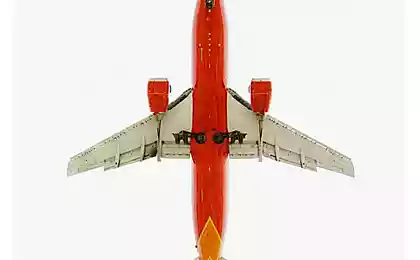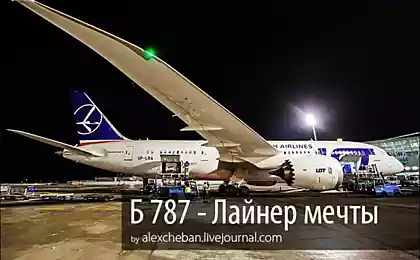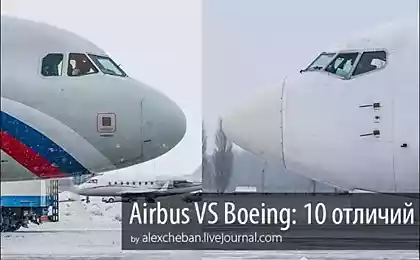1800
Emergency oxygen system Boeing-737 NG
When you sit in the chair of the passenger compartment of the aircraft, the top above you can see something like this (in the photo).
The fact that it is not very important, and that's inside there are more important :) I will tell you further ...
11 pcs.
via lx_photos / Engineering blog

Actually, at first I wanted to tell you about PSU.
But - where PSU, ibid, and oxygen. Therefore, adding only one photo and a few words, I'll tell you about the passenger oxygen system. As usual - simple and understandable.
So the passenger sees what is above him when sitting in the cabin of the aircraft Boeing-737 NG:
PS Here the box at the bottom (near the glowing cigarettes) - the monitor is folded entertainment system.
Today, we are not concerned with this topic.
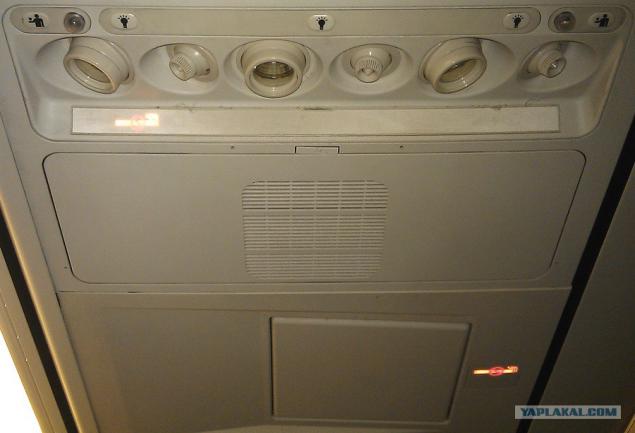
PSU (= Passenger Service Unit) - that's the hero of today's story.
Is this PSU on each row of seats, below the luggage rack.
(passenger service unit - so like in Russian turns)
At the bottom (photo) behind the bars of the live sound speaker. From a broadcast information to passengers by pilots or flight attendants, as well as some signals.

Above it we see stretched the full width of a set of facilities for passengers:
With at hand (one at the window, and one - the aisle) - the flight attendant call button. In the photo - in the upper right corner.
Pressing the warning light at the wire, will sound pleasant melody "dong" and the flight attendant necessarily suitable to the passenger on which lit the lamp.
Sometimes the button is pressed instead of the other passengers, located closer to the middle - buttons enable individual lighting (bulb drawn on it).
Diffuser of light visible in the left part of the photo.
To the right of a witness nipple individual ventilation. It can be directed in different directions, and turn-by-ribbed rim around the axis - to adjust the intensity of the blow.
Well, at the very bottom - signaling boards about fasten your seat belts. It operated from the cockpit.

Now it will be interesting - look at the PSU from the inside.
After the discovery, he hangs on to the United States specifically attached a string:

Crawl through to work in such a gap uncomfortable.
Therefore, usually disengaged the hook on a string with a ring, and falls below the PSU:
ut more interesting.
Orange hose submits to the left of the air conditioning system (maybe I will someday tell about it). Served time for individual ventilation.
Between them, and three of them, but with black tops - lighting individual lighting.
On the left edge, from top to bottom, stretches across the control module of the electrician, plus buttons and call lamps flight attendants.
Right in the middle - a loud speaker.
And the rest we are Walk carefully ...
The plane usually flies at an altitude where the oxygen content is very insufficient for life.
Therefore, in case of losing the ability to provide passengers with air at normal pressure of the air-conditioning system,
Flight also provides oxygen masks for the crew members and passengers.

At the top and bottom (photo) are parts of the PSU bays passenger oxygen masks.
Masks them two. That is, for each row of seats (usually three pieces) accounted for four masks.
It - margin for the seat with the child.
Masks can be automatically fall - with a decrease in cabin pressure to a pressure at an altitude of 14,000 feet (about 4, 5 km). Long before that, since the pressure corresponding to 10,000 feet, the cockpit alarm starts yelling.
But - you never know - and suddenly a defect, decompression, and so on.
In general, the air pressure sensor inside the aircraft provides a signal electrically rolled down the door, and all the masks fall out and hang on the cord.
Pilots may also be forced to throw out the passenger masks, if they consider it necessary. The switch is located on the cab roof panel.
Oxygen masks walked in here this gray hose, which is visible in the lower right corner of the previous photo.
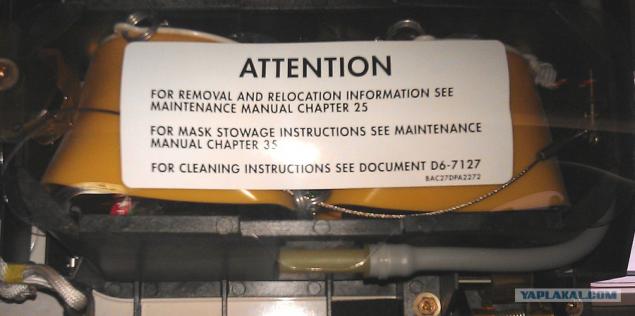
Unlike pilots, which in case of depressurization breathe pure oxygen from its single cylinder, passengers are not so lucky.
Oxygen is supplied to them from chemical generators:
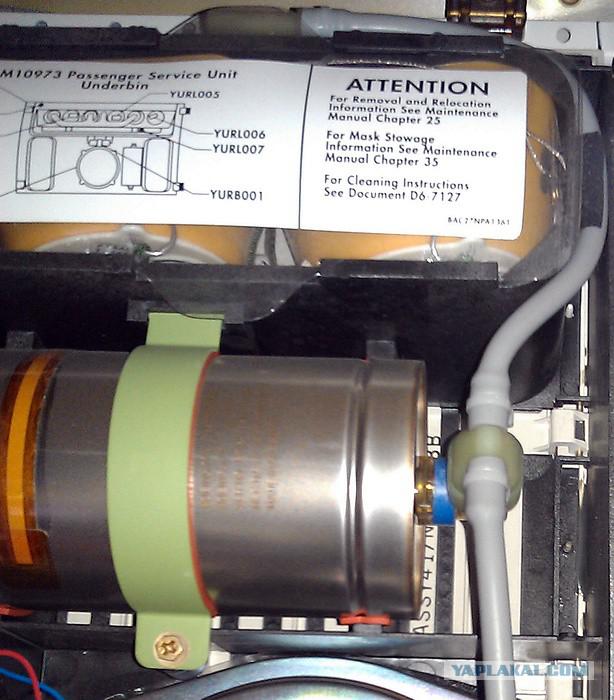
Here we see that the gray tube is connected to a metal cylinder.
This is Oxygen generator. One such generator is necessary for each row of seats (that is, one-on-one PSU).
The generator produces oxygen through a chemical reaction of sodium chlorate with iron, and it is impossible to stop it.
The duration of his work, as I recall, about 15 minutes. For which the aircraft is to be reduced to a safe altitude.
During operation, the generator is heated to 230 degrees so that the top area of bins may in principle little smoke. Afraid this is not necessary.
The orange stripe on the body of the generator turns black when heated, and shows that the generator is used.
After the die and fall, and the use of masks to be merry processing techniques for replacing or refilling masks and replacement exhaust generators.

On the left side you can see the generator device to run it.
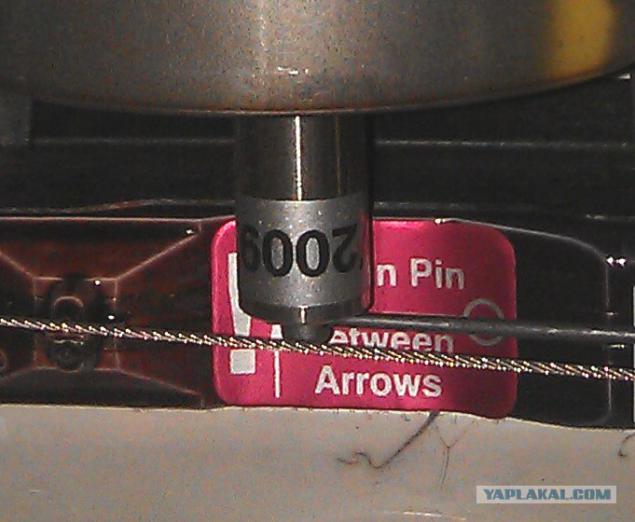
The principle here about like a hand grenade - has a spring-loaded striker, who held a small sleeve bridged.
Once the pin is pulled, the striker strikes the fuse and thus initiates a chemical reaction.
The pin is pulled out only mechanically, there is no electric no.
A rope from the pin through the system of wheels connected to a rope on which hang dumped oxygen masks:
So - if you suddenly tumbled masks throughout the cabin, and you feel that the air pressure is abnormal;
and even more so if it said the pilot or the flight attendants on the speakerphone,
it is necessary to pull the mask on yourself and wear.
Then natyanuvshiysya it will pull cord through the safety mechanism of the pin, and the oxygen generator over your head will work.
And who does not do so, that will not give oxygen.
The same chemical masks generators installed on cabin crew seats and toilets. If you look closely, there is the top in the ceiling panels also visible characteristic rectangular door.

Well, at the end of one more oxygen fines.
While this document does not apply to passenger system, but it would be strange not to mention.
In case someone from bad breath passengers on board are also portable oxygen tanks.
They are hidden in various towns secluded cabin.
Cylinders are equipped with shoulder straps for carrying on the shoulder, and they also attached oxygen masks - so that flight attendants can be moved around the cabin and assist passengers in normal flight, without resorting to chemical generators.
Roughly the same are arranged passenger oxygen system and other modern aircraft.
Thank you and good evening!
PS Now ask you babe - dad, and that ethno those things over our heads, and let you take and tell the whole inside story, the entire room heard.
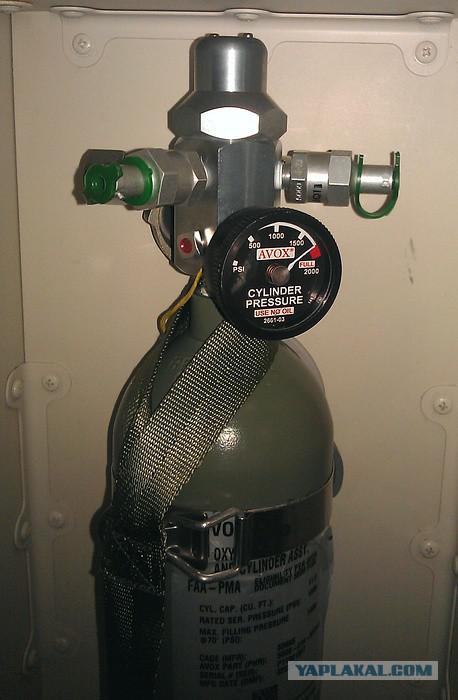
Source:
The fact that it is not very important, and that's inside there are more important :) I will tell you further ...
11 pcs.
via lx_photos / Engineering blog

Actually, at first I wanted to tell you about PSU.
But - where PSU, ibid, and oxygen. Therefore, adding only one photo and a few words, I'll tell you about the passenger oxygen system. As usual - simple and understandable.
So the passenger sees what is above him when sitting in the cabin of the aircraft Boeing-737 NG:
PS Here the box at the bottom (near the glowing cigarettes) - the monitor is folded entertainment system.
Today, we are not concerned with this topic.

PSU (= Passenger Service Unit) - that's the hero of today's story.
Is this PSU on each row of seats, below the luggage rack.
(passenger service unit - so like in Russian turns)
At the bottom (photo) behind the bars of the live sound speaker. From a broadcast information to passengers by pilots or flight attendants, as well as some signals.

Above it we see stretched the full width of a set of facilities for passengers:
With at hand (one at the window, and one - the aisle) - the flight attendant call button. In the photo - in the upper right corner.
Pressing the warning light at the wire, will sound pleasant melody "dong" and the flight attendant necessarily suitable to the passenger on which lit the lamp.
Sometimes the button is pressed instead of the other passengers, located closer to the middle - buttons enable individual lighting (bulb drawn on it).
Diffuser of light visible in the left part of the photo.
To the right of a witness nipple individual ventilation. It can be directed in different directions, and turn-by-ribbed rim around the axis - to adjust the intensity of the blow.
Well, at the very bottom - signaling boards about fasten your seat belts. It operated from the cockpit.

Now it will be interesting - look at the PSU from the inside.
After the discovery, he hangs on to the United States specifically attached a string:

Crawl through to work in such a gap uncomfortable.
Therefore, usually disengaged the hook on a string with a ring, and falls below the PSU:
ut more interesting.
Orange hose submits to the left of the air conditioning system (maybe I will someday tell about it). Served time for individual ventilation.
Between them, and three of them, but with black tops - lighting individual lighting.
On the left edge, from top to bottom, stretches across the control module of the electrician, plus buttons and call lamps flight attendants.
Right in the middle - a loud speaker.
And the rest we are Walk carefully ...
The plane usually flies at an altitude where the oxygen content is very insufficient for life.
Therefore, in case of losing the ability to provide passengers with air at normal pressure of the air-conditioning system,
Flight also provides oxygen masks for the crew members and passengers.

At the top and bottom (photo) are parts of the PSU bays passenger oxygen masks.
Masks them two. That is, for each row of seats (usually three pieces) accounted for four masks.
It - margin for the seat with the child.
Masks can be automatically fall - with a decrease in cabin pressure to a pressure at an altitude of 14,000 feet (about 4, 5 km). Long before that, since the pressure corresponding to 10,000 feet, the cockpit alarm starts yelling.
But - you never know - and suddenly a defect, decompression, and so on.
In general, the air pressure sensor inside the aircraft provides a signal electrically rolled down the door, and all the masks fall out and hang on the cord.
Pilots may also be forced to throw out the passenger masks, if they consider it necessary. The switch is located on the cab roof panel.
Oxygen masks walked in here this gray hose, which is visible in the lower right corner of the previous photo.

Unlike pilots, which in case of depressurization breathe pure oxygen from its single cylinder, passengers are not so lucky.
Oxygen is supplied to them from chemical generators:

Here we see that the gray tube is connected to a metal cylinder.
This is Oxygen generator. One such generator is necessary for each row of seats (that is, one-on-one PSU).
The generator produces oxygen through a chemical reaction of sodium chlorate with iron, and it is impossible to stop it.
The duration of his work, as I recall, about 15 minutes. For which the aircraft is to be reduced to a safe altitude.
During operation, the generator is heated to 230 degrees so that the top area of bins may in principle little smoke. Afraid this is not necessary.
The orange stripe on the body of the generator turns black when heated, and shows that the generator is used.
After the die and fall, and the use of masks to be merry processing techniques for replacing or refilling masks and replacement exhaust generators.

On the left side you can see the generator device to run it.

The principle here about like a hand grenade - has a spring-loaded striker, who held a small sleeve bridged.
Once the pin is pulled, the striker strikes the fuse and thus initiates a chemical reaction.
The pin is pulled out only mechanically, there is no electric no.
A rope from the pin through the system of wheels connected to a rope on which hang dumped oxygen masks:
So - if you suddenly tumbled masks throughout the cabin, and you feel that the air pressure is abnormal;
and even more so if it said the pilot or the flight attendants on the speakerphone,
it is necessary to pull the mask on yourself and wear.
Then natyanuvshiysya it will pull cord through the safety mechanism of the pin, and the oxygen generator over your head will work.
And who does not do so, that will not give oxygen.
The same chemical masks generators installed on cabin crew seats and toilets. If you look closely, there is the top in the ceiling panels also visible characteristic rectangular door.

Well, at the end of one more oxygen fines.
While this document does not apply to passenger system, but it would be strange not to mention.
In case someone from bad breath passengers on board are also portable oxygen tanks.
They are hidden in various towns secluded cabin.
Cylinders are equipped with shoulder straps for carrying on the shoulder, and they also attached oxygen masks - so that flight attendants can be moved around the cabin and assist passengers in normal flight, without resorting to chemical generators.
Roughly the same are arranged passenger oxygen system and other modern aircraft.
Thank you and good evening!
PS Now ask you babe - dad, and that ethno those things over our heads, and let you take and tell the whole inside story, the entire room heard.

Source:

